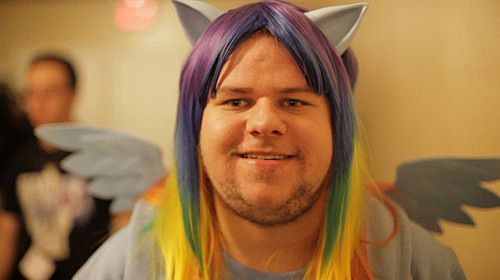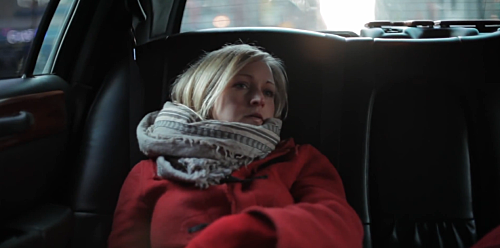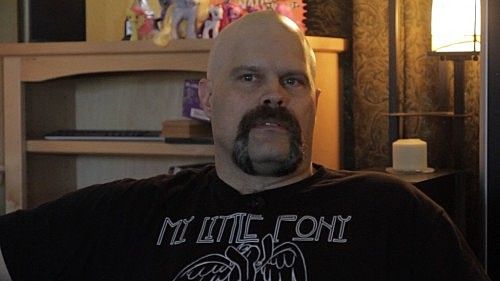Somewhere Over The Rainbow: Brent Hodge’s “A Brony Tale”
Canadian-New Zealander Brent Hodge has crafted the feel-good documentary of the year with his expose of grown-ass My Little Pony fans and the people who love them. He talks to Joe Nunweek about the process of assembling the film, and the original direction he’s glad he avoided.
At what should have been the height of VHS, one of my earliest memories is how decrepit video store across from the Rocket Park in Mt Albert was. Our local had a grand total of about 40 children’s videos. As the oldest, I made sure we started with the good ones – Thomas The Tank Engine, Fireman Sam, The Flintstones. Then there was the second tier – Huckleberry Hound, inscrutable Looney Tunes compilations that seemed, even then, to include a bunch of weird bootleg stuff. Eventually, I even resorted to Care Bears, Rainbow Brite, and My Little Pony. My younger sister was delighted. Surprisingly, I was very happy too. We devoured them omnivorously, obliviously.
I’ve always thought of this with a flicker of self-consciousness whenever I’ve seen bronies mentioned online. Over the past five years, adult fans of My Little Pony have inundated the internet. They thrill to an ensemble of characters with names like “Pinkie Pie” and “Fluttershy”. They memorise placenames like “Ponyville” and “Equestria” like some sort of Tolkien scratchmap. According to studies, they are overwhelmingly male, and the majority are straight.
Though I’m yet to meet a true fan in the flesh, Brent Hodge’s A Brony Tale, which makes its bow at the Documentary Edge festival this week, is the next best thing. The coverage itself isn’t new: plenty of lazy drive-by exercises in reminding us that bronies like a programme for young girls have been appended to late-night news shows. But Hodge takes a more interesting and uplifting path, though he admits when I Skype him that it didn’t start that way.
“All my judgment went out the window. I went into it thinking – ‘alright – this is creepy, I’m going to find some creepy stuff, everyone’s going to love the creepiness.’ But I decided – I’m going to sit down, I’m going to watch this show, I’m going to see if I get hooked.”
Hodge – a Canadian-born Kiwi citizen by one parent, and a self-professed ‘scarfie’ who finished undergrad in Dunedin – explains that it was serendipitous. “I worked at Radio One in Otago as a sort of part-time student thing when I was down there, and later I was able to take what I’d picked up and channel it into doing some stuff with the CBC when I returned to Canada. That’s where I met Ashleigh Ball, through doing some radio sessions with her band, Hey Ocean!”
Hodge and Ball became fast friends. She's a gifted musician, but being in a late 2000s Canadian indie-pop band was about as lucrative as you’d imagine. She turned her talents to voice acting instead – she nailed “Oopsy Bear” in the 21st-century Care Bear revival, gave a resonance to “Plum Pudding” in a Strawberry Shortcake redux. Then, she made her breakthrough in 2010 with My Little Pony: Friendship Is Magic (the fourth iteration of the franchise overall). She plays Applejack (the kind but stubborn pony) and Rainbow Dash (the bold but arrogant one). If these seem like rote cyphers, you should see Ball switch between them.
“I was catching up with her one night and asking how it was going,” Hodge recalls. “She said: “It’s been great, it’s already at Season Two” – but there’s these guys who have been emailing me.” I replied, “Guys?” And then I asked to see to some of the emails, and it was just phenomenal. These guys were emailing wanting to know the backstories and metaphors of the characters she was doing – I mean they were really trying to deconstruct this kids’ programme like it was this flagship sci-fi show with all of these arcs and twists and turns. When really the show is nothing like that.”
But then, My Little Pony: Friendship Is Magic did pull a trick that prestige TV has done for the past decade – it bought into the cult of the showrunner. Lauren Faust had previously clocked serious time on The Powerpuff Girls, a children’s series that racked up its own cult following. What she developed with MLP: FIM is patently for kids – but it’s also an odd postmodern pastiche, mixing very straightforward storytelling with the kind of pop culture references destined to go over a toddler’s head.
“It had this Japanimation, flash animation feel to it with a lot of references for adults. Nods to Star Wars, Benny Hill – all these shows a little girl really wouldn’t understand. I still don’t know if it backfired on them or if it just got men involved and into it.”
Hodge, to his credit, threw himself into research by the most direct means possible. “And I almost took a liking to it because it’s Ashleigh and I can tell it’s her voice, and she’s done these characters for me…but I just didn’t get into it the same way these guys do. The shows are good, they’re well done – the stories are great too. I just didn’t connect the same way these guys did. I really don’t think it’s about the show.”
In its final form, A Brony Tale feels like a celebratory road-trip, a stop-by-stop series of encounters with high schoolers, college students, activists, DJs, veterans, academics and bikers – bronies all. Drifting eastward, it all feels like it’s building up to the 2012 Brony Con and Ashleigh’s own reckoning – will she choose to keep an austere distance from these grown men, or will she help them celebrate their peculiar obsession? Speaking to Hodge, I’m surprised to learn that much of the film’s arc had to be constructed later on. Outside the diegesis, A Brony Tale virtually started where it ends.
“We had just started filming it. We had some fun, and before we knew it someone got wind of it online, and we got invited to BronyCon. I thought I’d just document it for Ashleigh’s journal. I thought it could be something for her to show her kids one day – instead it just snowballed.
“I cut a five-minute piece, and then a ten-minute piece that might have worked as a short – and then before I knew it we had this traction from big companies who said we should turn it into a full doc. At that stage, I didn’t wait. I just went for it. I really found that I needed to fill it in and explain what the bronies are.”
The 2012 BronyCon Hodge attended had 1,000 attendees. This August’s will have 10,000. But the timing wasn’t as good as it could have been. “My first leg of filming was fine,” he recalls, “but then Howard Stern, FOX News, started coming out with these horrible three-minute pieces. You know, saying these guys were perverts, that what they do online is terrible. I really wanted to show exactly what I saw. I never shied away from that. I never lied, or said ‘This is a brony doc that’s going to promote you guys.’ I told them I’d shoot exactly what I see. And I think they respected that.”
With the light of distribution to keep him going at the end of the tunnel, Hodge soldiered on self-funded. “I didn’t want this to come from any kind of production company. Most of the time I shot on my own.” Being proud of your online persona or your fandom amid a close circle of friends is one thing, but going on screen and opening up is quite another. ““I would say not a lot of these were 15 minute Q and A’s. And the thing about self-funding is that I was in a position where I could spend three weeks coaxing things out if I had to. I don’t know if I’ll ever get to do that again – when you’re spending other people’s money, it’s not easy to do.”
Hodge estimates he did time with at least 50 bronies one-on-one, and felt obliged to do more than present them as a cavalcade of freaks. The first person we encounter after Ball is Dusty Katt , a burly unit of a man who works on bikes in San Jose and hosts the URL manliestbrony.com. He’s a double bluff on the audience’s expectations – a dude who couldn’t be further from the stereotypical image of a brony fan, but then also turns out to be one of the show’s best and most self-effacing advocates, doing the heavy lifting of exposition that would be hard for an outsider to pull off.
But it’s Brian, a Iraq War veteran experiencing PTSD, who offers the film’s emotional core. He shifts the focus of the film from mere quirk to the idea that solace comes in a lot of forms, and that the question of “is it normal?” is less valuable than “is it helping?”
“I had Brian’s story explained to me by, and I instantly got on a flight to meet him. I’m honestly a little bit scared that I’ll never find someone like that again in my documentary career," he reflects. "I really got lucky with him, and I had to be patient. He wasn’t the kind of guy who just opened up right way. We had to spend time together, days in Minnesota hanging out.”
The process of establishing that trust means there’s a couple of paths not taken. Of course you can go onto DeviantArt and find muscular, big-cocked ponies in full rut. But with A Brony Tale, Hodge concluded that going there would breach too much faith he’d built up with the community in exchange for a pretty unenlightening observation (namely, that there is weird porn on the internet).
“You can go online yourself, you can see the crap that’s there. There’s this concept called ‘Rule 34’, where if it becomes popular on the internet it gets turned into some kind of sexual fantasy. The same thing goes with this. I know it’s a concern for a lot of bronies. And then I concluded that this story doesn’t even need it.”
Hodge’s careful take appears to have paid off. “I thought it was going to go two ways. Bronies are going to either love it and cheer it and the film industry is going to think this is the weirdest thing or vice versa, it’s going to be acclaimed but offend a lot of people who invested in it.” It did neither – the reviews are glowing, and Hodge is warmly approached by bronies of all stripes after screenings, though he never became embedded enough to count himself in their ranks.
“I was talking to a brony a couple of weeks ago at Tribeca, where we launched, and I told him ‘It’s funny – I still field all these questions at these Q and A’s as if I’m a brony expert, but I really can’t hammer out why you guys like the show. It doesn’t make sense.’ And he said, ‘I don’t know if it was ever really meant to make sense.’ And I thought, that’s the perfect response. It is what it is. The show makes you feel good. There’s no dark elements. It’s quite contagious.”
“And – it’s well made, and the stories are great too,” he muses. “I just didn’t connect the same way these guys did. I mean, this is a show about six ponys in Ponyville going to school and learning from each other. I really don’t think it’s about the show.” He suspects that at this point, it’s less about what happens on screen than how people socialise beyond it. “There’s a lot of people who have never played hockey or rugby before, but they’re an All Blacks fan. You come for the show or game, you stay for the community.”
A Brony Tale premieres at Documentary Edge, Q Theatre, Auckland on Friday 30 May and Sunday 1 June. It also screens in Wellington on 8 June and 13 June.




